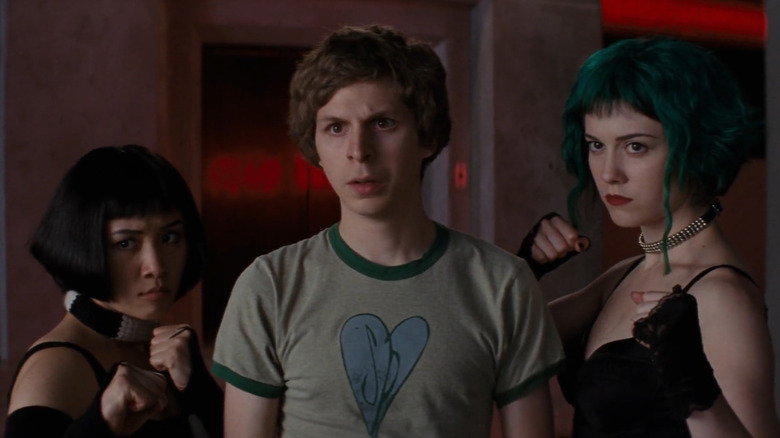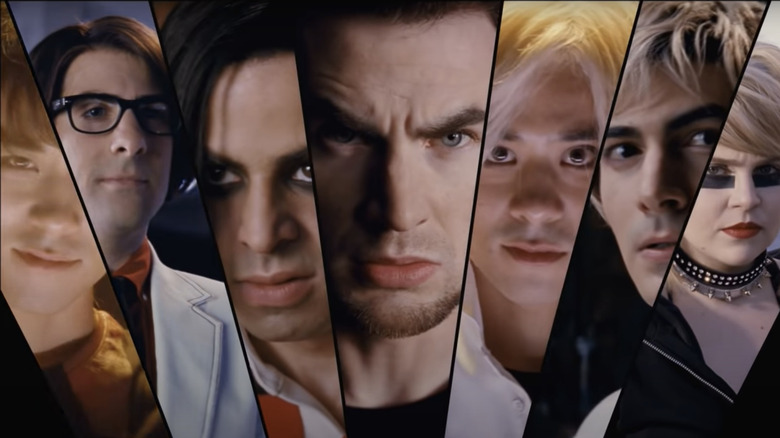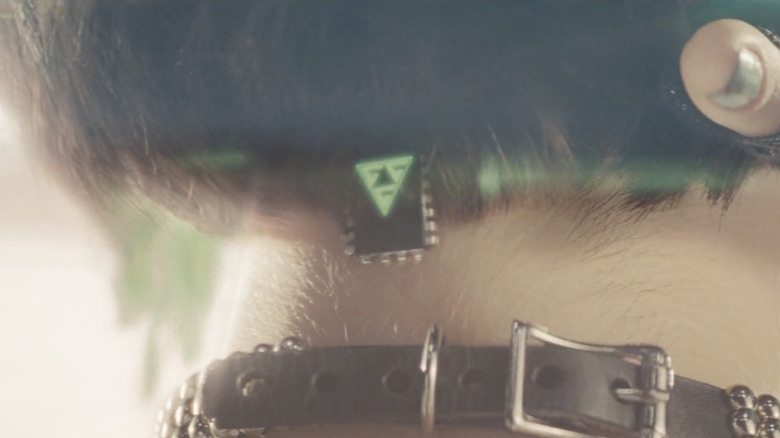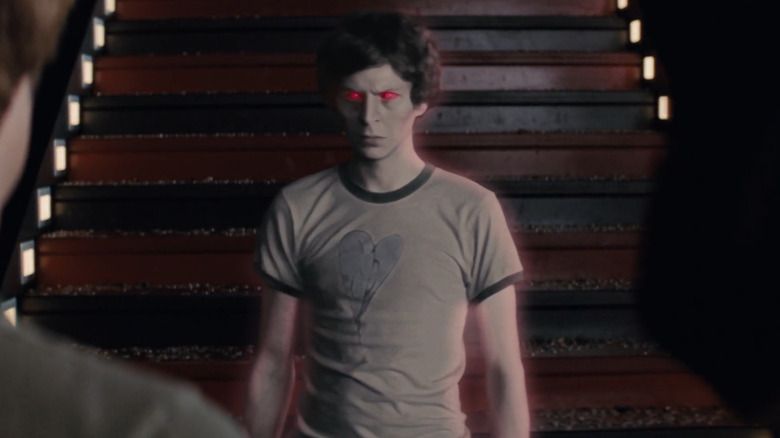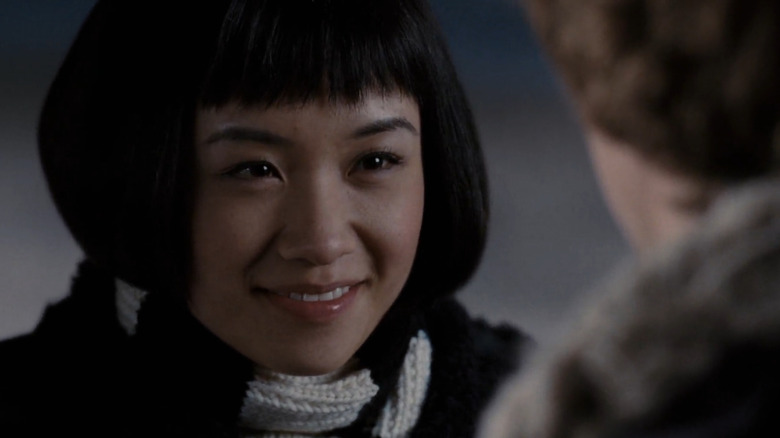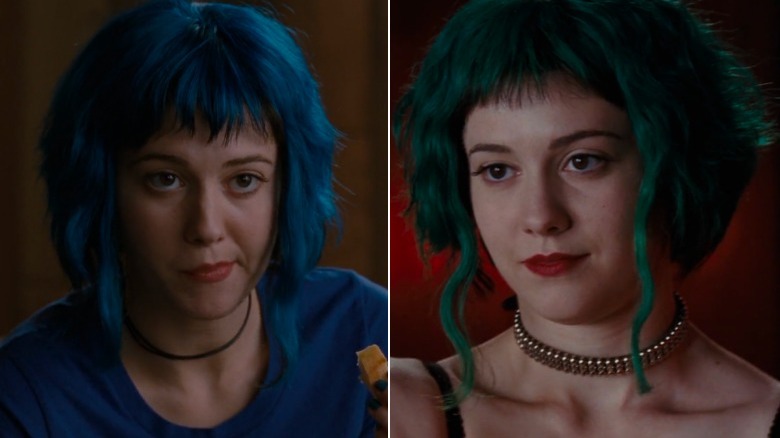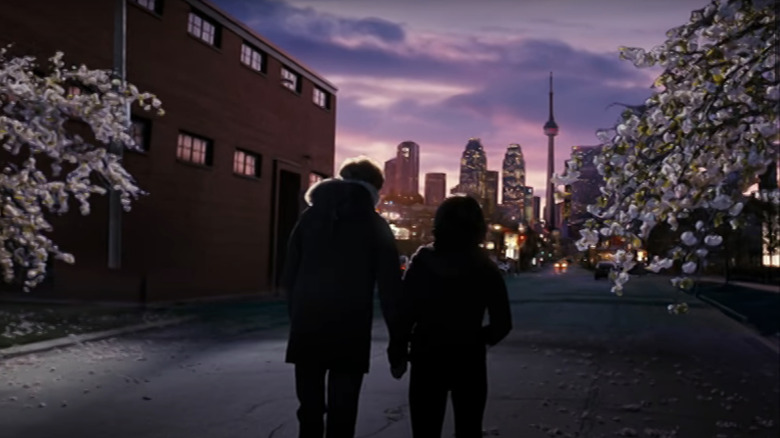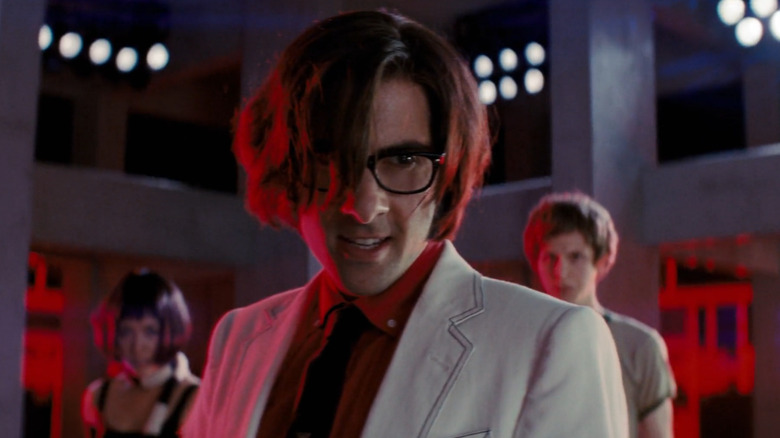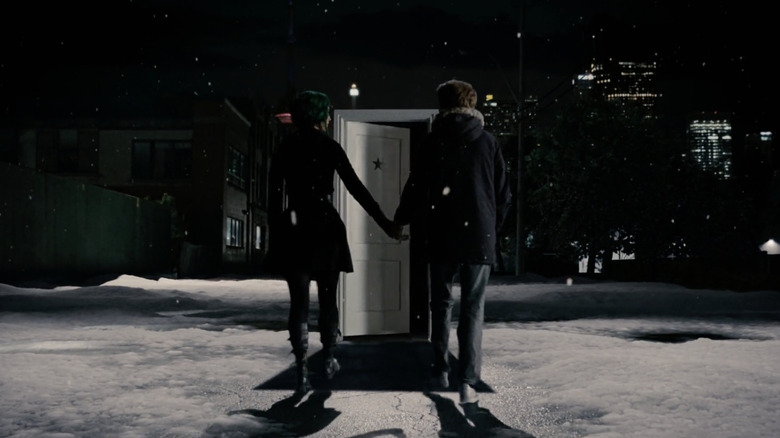The Ending Of Scott Pilgrim Vs. The World Finally Explained
Since the release of "Scott Pilgrim vs. the World" in 2010, fans have been pining for a sequel. Directed by Edgar Wright (then of "Shaun of the Dead" and "Hot Fuzz" fame), the film is an adaptation of artist Bryan Lee O'Malley's "Scott Pilgrim" series of graphic novels that ran from 2004 to 2010. Despite its box-office failure (grossing just a little over $47 million worldwide on a budget of $60 million), the film became an immediate favorite of critics and fans alike and went on to become a cult classic in the years since.
"Scott Pilgrim" has it all — a coming-of-age romance with fun action, unique humor, and an engaging visual style — with a pitch-perfect ensemble cast that includes Michael Cera, Mary Elizabeth Winstead, Chris Evans, Brie Larson, and Aubrey Plaza, just to name a few. Naturally as with any adaptation, the filmmakers had to take certain liberties to compress the expansive world and details of the characters in O'Malley's "Scott Pilgrim" series, which ran for six volumes amounting to over 1,200 pages, within a coherent film of 120 minutes.
As a result, a lot of elements introduced or alluded to in the film may not have had their appropriate resolution, which understandably would've left you confused, unless you're all caught up with the graphic novels. With a "Scott Pilgrim" anime series announced by Netflix that is bringing back the whole cast of the movie, now's the perfect time to revisit the film adaptation and its ending.
The League of Evil Exes
After finally ending his pseudo-relationship with Knives (Ellen Wong), all seems perfect between Scott (Cera) and his new girlfriend Ramona (Winstead). That is until he's attacked by Matthew Patel (Satya Bhabha), Ramona's ex from the 7th grade. Scott learns that all of Ramona's exes have formed a "League of Evil Exes" for the sole purpose of preventing him from dating Ramona. Other members include Lucas Lee (Evans), Todd Ingram (Brandan Routh), Roxanne Richter (Mae Whitman), and the Katyanagi twins (Keita Saitou and Shôta Saitô).
At the climax, it is revealed that Gideon Graves (Jason Schwartzman), a powerful music mogul and Ramona's most recent ex, had assembled the league. Furthermore, he is "G-Man," the manager of Scott's band, further complicating Scott's friendship with his bandmates. While the film doesn't explore Gideon's backstory, Ramona tells Scott in his desert dream that during her time with Gideon, he never paid any attention to her until after she had broken up with him. As a result of his obsession with Ramona, Gideon felt compelled to track down each of her exes and convince (or manipulate) them into joining the league.
Fans of the movie have frequently questioned whether all of the antagonists in the movie die after being defeated, given that they disintegrate into pixel fragments. O'Malley responded to one of these questions on his Tumblr page, confirming that nobody dies in the series; instead, everyone simply respawns at their houses after having learned their lessons.
Ramona has a literal chip on her neck (and maybe so do the other exes)
After his breakup with Ramona, Scott spots her with Gideon who tells Scott that he and Ramona are back together as she seems helpless in complying with everything Gideon tells her to do. When Scott ends up in a desert-like purgatory after his defeat to Gideon, Ramona reveals that Gideon installed a chip on her neck that allows him to control her actions, which explains why she was so defenseless while watching Gideon kill Scott.
The film adaptation uses the mind-control chip as a replacement for the more complicated "Glow" from the graphic novels. The Glow, much like the chip, is created by Gideon essentially as a means to weaponize anyone's emotions against them (especially Ramona's). While it's never revealed how Gideon manipulated Ramona's exes to join the "League of Evil Exes," fans have come up with their own interesting theory that connects the elements of the chip with the evil exes' motivation to battle Scott.
According to the Scott Pilgrim fandom community, Gideon didn't just use the chip to control Ramona, but also to control the exes. It's the most plausible explanation as to why the members are willing to sacrifice their lives to control the love life of someone with whom they had a brief affair in the past. During Scott and Ramona's battle with Roxy Richter, Roxy exclaims "If Gideon can't have you then no one can," which further substantiates this theory.
What's up with Nega Scott?
After beating Gideon, there is still one more foe for Scott to defeat: Nega Scott, a gray-skinned, red-eyed, and seemingly evil version of Scott. As the two are set to throw down, the film abruptly cuts to the pair leaving Gideon's club and making plans to meet up later. Scott tells Ramona and Knives that Nega Scott turned out to be a pretty nice guy, and they carry on. This moment, as well as the sudden inclusion (and subversion) of Nega Scott as a false antagonist in the film, had audiences scratching their heads.
In the graphic novel, Nega Scott has a greater symbolic significance as a recurring personification of Scott's flaws, whom Scott eventually has to confront and accept. While the character's appearance in the film adaptation was too short for audiences to register any hidden symbolism, upon reading the graphic novel, it can be inferred that Scott ultimately befriending the literal manifestation of his imperfections is representative of him accepting his own flaws after having fought for Ramona and reconciled with her and Knives for cheating on them both.
His appearance is foreshadowed by the "Ninja Ninja Revolution" game that Scott and Knives play at the arcade, where Scott is struggling to defeat the final boss. He's also foreshadowed in two deleted scenes where Scott gets spooked by Nega-Scott appearing in a mirror reflection: one in the bathroom at the club where Sex Bob-Omb's "Battle of the Bands" takes place, and another when Scott and Ramona have a squabble before his fight with Roxy.
Knives lets go of Scott
It goes without saying that 22-year-old Scott's relationship with 17-year-old Knives was unhealthy and largely unbalanced. Even if unintentionally, Scott misleads the naive and immature Knives into believing they're in a committed relationship when he's actually only using her as a rebound to move on from his ex, Envy Adams (Larson). Moreover, Scott breaks up with Knives mere seconds after she confesses her love for him, after which she starts stalking him and spying on his time with Ramona, cultivating hatred for her and dyeing her own hair blue to match that of Ramona's.
Thankfully, Knives' obsession with Scott is subverted into a character arc where she finally moves on from Scott, stating that she deserves someone better than Scott and encouraging him to go with Ramona. Though she may initially have come across as an annoying character that both Scott and the audience have to get through before the real story begins, towards the end of the film, Knives emerges as the benevolent dark horse amid the other vastly flawed characters in the film.
There was an original ending that showed Scott and Knives getting back together before it was reshot to the ending that we see in the theatrical cut. O'Malley revealed through his Tumblr page that the original ending had polarized audiences at the test screenings, writing, "My main problem with [the ending] was that it made Knives a weaker character," further revealing that he wrote the line "I'm too cool for you anyway" for Knives at the end: "I wanted her to move on from him, not just give up on him."
Ramona's hair colors and other video game references
The film is brimmed with tributes to vintage video games that are carried over from its source graphic novel. The pee-bar, the VS. sign before each boss battle between Scott and Ramona's ex-lovers, and the "1-up" extra life Scott receives after defeating the Katayanagi twins are just a few of the outright stylistic allusions to video games in general.
Many references are made to actual video games that would have any avid gamer gleefully point at their screens. Some of these references are obvious, like the arcade game that Scott and Knives play together, which is a clear spoof of the popular dance arcade game, "Dance Dance Revolution." The appearance of Nega Scott is synonymous with the design of Dark Link, an evil version of protagonist Link in the "Legend of Zelda" games; and Gideon's "G-Man" nickname is taken from the elusive recurring character of the same name in the "Half-Life" series.
Ramona's hair colors, which itself becomes part of the visual language of the film, are likely subtle references to the colors of the "Golden Goddesses" from the "Legend of Zelda" games, namely Din — the Goddess of Power (pink), Nayru, the Goddess of Wisdom (blue), and Farore, the Goddess of Courage (green). The movie also borrows musical themes from several iconic video game franchises, including "Street Fighter," "Tekken," "Pac-Man," and "Final Fantasy."
The original ending where Scott goes with Knives
Since the film was written and primarily shot before the final issue of the graphic novel was completed, the filmmakers had to improvise the ending since O'Malley himself wasn't sure how he was going to end the story of Scott Pilgrim. An ending where Scott reconciles with Knives was shot, letting Ramona continue on her own. To foreshadow the now-deleted scene, the desert sequence had some additional footage where Scott tells Ramona that he really fought for her, to which Ramona responds that "someone was fighting pretty hard for you, too," implying Knives.
Ramona further reveals that she wished that she was "fanatically devoted" to someone as Knives was to him, which reminds Scott of how much Knives loves him. After using his extra life to resurrect himself, Scott (in a voice-over monologue) realizes who he now must fight for this time: Knives. With this version of the desert dream sequence, the original ending shows Scott and Ramona sharing a heartfelt goodbye, after which Scott and Knives walk into the sunrise as Ramona walks alone into the door.
A final scene shows Scott and Knives playing the ninja game together as a team, much like they did earlier in the film. Since this ending divided the audiences at test screenings, Wright worked with O'Malley and screenwriter Michael Bacall to rewrite the ending after Wright saw O'Malley's rough notes for the final volume of the graphic novel.
Other ideas for the ending that were unshot
Given that the filmmakers had to pretty much wing the climax and ending of the film adaptation of O'Malley's "Scott Pilgrim" graphic novels, whacky ideas were brainstormed for the final battle between Scott and Gideon (as well as how the film could possibly end), that were either scrapped during the ideation stage itself, rewritten for budgetary constraints or were left unshot due to lack of time.
According to The Playlist, at a preview screening of the film prior to its release, Wright divulged one of the ending ideas that would have revealed that the entire events of the film were a dream. A final shot would show a news report on television saying that "a local Toronto teen has killed seven people," implying that Scott defeating Ramona's exes was a fever dream that would turn out to be actual murders committed by him. Wright further revealed, "Yeah, we nearly shot that on video during the reshoots — but dammit, we only had six hours of night and no time to do it — [it] would have been funny."
Another ending that was discarded was that of Gideon turning into a Transformers-like robot at the end of his battle with Scott. Wright revealed (per MTV), "The original ending had Gideon turning into a giant robot ... that never went anywhere. We got rid of that because Bryan [Lee O'Malley] wasn't going to do that in the comics, and also we thought it would look like a 'Transformers' spoof, so we ditched it."
Is the upcoming Netflix anime a sequel to the film?
In March 2023, Netflix and Wright shared a video announcing that all the original cast members of the 2010 film adaptation are returning to voice their respective characters in the upcoming Netflix anime titled "Scott Pilgrim The Anime." Additionally, O'Malley will serve as co-writer, executive producer, and co-showrunner with BenDavid Grabinski, and Wright will be contributing as an executive producer.
While fans were ecstatic about the announcement, there were still questions lingering about whether the anime would continue the story of Wright's film adaptation. Wright explained to Netflix's Tudum, "Over the years fans had asked if there would be a sequel to the film or some other kind of continuation ... I knew that a live action sequel was unlikely, but I would usually defer by suggesting that perhaps an anime adaptation was an interesting way to go. And then, lo and behold, one day Netflix got in touch to ask about this exact idea. But even better, our brilliant creator Bryan Lee O'Malley had an idea that was way more adventurous than just a straight adaptation of the original books."
Though the anime series won't be a sequel, fans need not fret as they can expect a more faithful adaptation to O'Malley's graphic novels that would delve into the expansive world of Scott Pilgrim and its characters in greater detail, much more than the film could be given its limited two-hour runtime. Given how Wright and O'Malley closely collaborated on the film adaptation of the latter's graphic novels, there's no doubt for fans that the anime of their beloved franchise is in very good hands.
